This document shows the development status of a new Valkyrie fighter, namely VF-11 Thunderbolt. The work started at the end of 1999 and is still going on, but has finally reached a 70% completeness status.
VF-11 Thunderbolt (VF-11 or Thud from now on) was first introduced in Macross Plus and Macross 7 as an evolution of the old, non transformable VF-4 fighter. Produced by Shinsei Industries, it became widely used until 2040. Then, in order to find a substitute for this ageing vehicle, project Super Nova was set up and the outcome was the introduction of VF-19 fighters as we can see them in Macross 7.
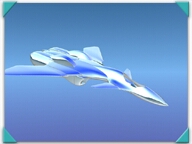 Despite its age, VF-11 is IMHO way better than VF-19, and at par with YF-19. It's shape is more traditional, resembling the russian airplanes of late 90ies such as Su27 Flanker and SuperFlanker or Mig29 Fulcrum. It also boasts intresting space expansions, and that's why I decided to go for a model try...
Despite its age, VF-11 is IMHO way better than VF-19, and at par with YF-19. It's shape is more traditional, resembling the russian airplanes of late 90ies such as Su27 Flanker and SuperFlanker or Mig29 Fulcrum. It also boasts intresting space expansions, and that's why I decided to go for a model try...
The picture on the right is quite recent, showing the Thud with a good amount of "pieces". It has canards and intakes, but still lacks back wings and body plates. As you can see the cab is missing, but the nose is good and almost definitive.
I used a top and side projection of the plane as a base for modeling, both coming from a drawing from Shoji Kawamori (the mecha designer of Macross, Macross Plus and Macross 7). Some pictures of an 1:44 BANDAI scale plastic model were of use too, despite being quite misproportioned..
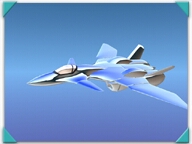 The second and third pictures are more recent, dating the second week of January. The cab is finally there, but it took a lot of effort to provide it the right shape. I'm using a new modeler, SolidThinking, wich is a NURBS oriented parametric surface modeler. It's realy good, allowing for several tweaks and fine adjustments.
The second and third pictures are more recent, dating the second week of January. The cab is finally there, but it took a lot of effort to provide it the right shape. I'm using a new modeler, SolidThinking, wich is a NURBS oriented parametric surface modeler. It's realy good, allowing for several tweaks and fine adjustments.
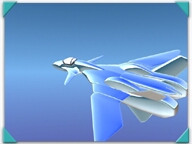 It's quite evident from picture three that the back panel, the one that becomes the Battroid's shield, is justapposed on the plane's body and doesn't fit very smoothly. This is going to be fixed soon, and new top panels are going to appear. One thing that puts me down is that it's quite difficult to find good pictures of the tail and back of this fighter.
It's quite evident from picture three that the back panel, the one that becomes the Battroid's shield, is justapposed on the plane's body and doesn't fit very smoothly. This is going to be fixed soon, and new top panels are going to appear. One thing that puts me down is that it's quite difficult to find good pictures of the tail and back of this fighter.
As a consequence I'll have to work out a good arrangement for the head's gun and plates. Feet should not be a problem, they are going to appear soon, as soon as I can find a good method for cutting holes in the back of the legs. All the vertical planes are now present, and they're definitely good.

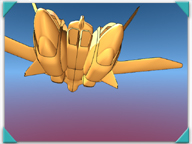
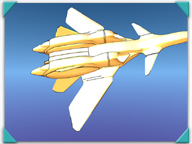 One of the hardest tasks when modeling an anime transformable plane is that a lot of things simply can't fit well together. I spent a lot of time investigating the best way to convey that round shape to the legs, without sacrificing the in-between space for the arms.
One of the hardest tasks when modeling an anime transformable plane is that a lot of things simply can't fit well together. I spent a lot of time investigating the best way to convey that round shape to the legs, without sacrificing the in-between space for the arms.
You can see the result in this serie of pictures. These are LW test renderings, with evident flaws like the dark line running along the fighter symmetry plane, of course this will be fixed in the finished version; it's just a matter of redundant points. I decided to use LW excellent polygon cel-look edges, to hilight the shape of the fighter.
Feet have been added too, but I still have to fill the holes cut to contain them. I think they are quite good anyway.
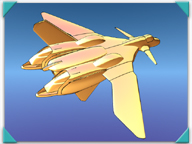 You can see the legs and feet more clearly in this shot from the tail of the Thud. They are still hollow, but that's only a matter of adding a single surface, and I'm not going to do it until they're not at all satisfying. I've also changed slightly the proportions of the fighter. The nose is longer and smoother, while the body is "chunkier".
You can see the legs and feet more clearly in this shot from the tail of the Thud. They are still hollow, but that's only a matter of adding a single surface, and I'm not going to do it until they're not at all satisfying. I've also changed slightly the proportions of the fighter. The nose is longer and smoother, while the body is "chunkier".
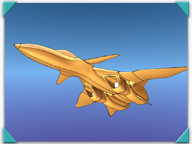
The final part of the fuselage has been enlarged and reshaped to smoothly fade into the main body. This part is going to gain detail through stencil trimmings and perhaps added structures, but the main task now is just to provide the main lines of its shape.
You can see the new general appearance of the plane in this last picture. The legs are widely separated, and the intakes have been rounded a lot. This shot was ugly with the previous versions of the model, while now it looks really good.

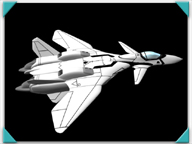 All the works in this days went in the direction of providing a good panels' scheme for my VF-11. Thanks to the rebirth of Hobby Link Japan website I was able to find some really good VF-11 models to use as a source for further development of both model and textures. The legs needed a slight rearrangement, and the same was true for the blocks just above the plane's top.
All the works in this days went in the direction of providing a good panels' scheme for my VF-11. Thanks to the rebirth of Hobby Link Japan website I was able to find some really good VF-11 models to use as a source for further development of both model and textures. The legs needed a slight rearrangement, and the same was true for the blocks just above the plane's top.

Now that the model is almost complete I can start seriously adding details and panels. I decided to start with traditional textures, but maybe I'll step back to the technique of cutting every single black line in the polygonal structure of the plain. It depends largely on the results I'll obtain with this complex multitexturing affair. Sadly enough Lightwave doesn't support UV Maps, so a lot of AlphaChannel tricks are to be played...
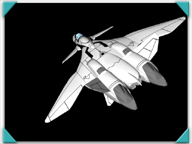 You can see the side-effects of this multichannel texturing in the picture on the right: part of the top fuselage texture runs through the plane and is visible in the lower part of the fuselage itself. That's something I'm going to fix ASAP, but no such problems arise if the details are polygonal... An advantage of traditional multitexturing is that one can do slight adjustments in a few seconds and see them immediately reflected in the OpenGL preview.
You can see the side-effects of this multichannel texturing in the picture on the right: part of the top fuselage texture runs through the plane and is visible in the lower part of the fuselage itself. That's something I'm going to fix ASAP, but no such problems arise if the details are polygonal... An advantage of traditional multitexturing is that one can do slight adjustments in a few seconds and see them immediately reflected in the OpenGL preview.
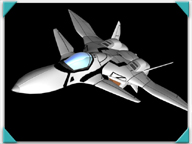 All that is left to do is tweaking legs' surfaces and finding a good arrangement for feet; then, once the texturing and weathering is finished, the model will appear in a new gallery. I'm going to paint it in the grey/red scheme you can find in Macross Plus, rather than the dull white of Macross7...
All that is left to do is tweaking legs' surfaces and finding a good arrangement for feet; then, once the texturing and weathering is finished, the model will appear in a new gallery. I'm going to paint it in the grey/red scheme you can find in Macross Plus, rather than the dull white of Macross7...